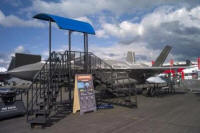|
 'Excessive'
rubbing of engine blades caused F-35 failure: Pentagon 'Excessive'
rubbing of engine blades caused F-35 failure: Pentagon
 Send a link to a friend
Send a link to a friend
[July 14, 2014]
By Andrea Shalal
LONDON (Reuters) - The engine failure that
has grounded the entire fleet of Lockheed Martin Corp F-35 fighter jets
was caused by "excessive" rubbing of fan blades in the plane's Pratt &
Whitney engine, but does not appear to be a fundamental design flaw, the
Pentagon's chief weapons buyer said on Sunday.
|
|
 Defense Undersecretary Frank Kendall told reporters on Sunday
there was still a chance that the grounding order could be lifted in
time for the F-35 to make its international debut at the Farnborough
air show. Defense Undersecretary Frank Kendall told reporters on Sunday
there was still a chance that the grounding order could be lifted in
time for the F-35 to make its international debut at the Farnborough
air show.
Organizers of the show confirmed that the F-35 would not appear on
Monday, but said it could still arrive and fly later in the week.
The United States' newest combat jet had already been pulled out of
a British military show last week, after the entire fleet was
grounded following a massive engine failure on a U.S. Air Force F-35
at a Florida air force base on June 23.
Kendall said the grounding had halted testing but he did not view
the incident as a "fundamental setback" for the $400 billion
program, the Pentagon's biggest, which still has about 40 percent of
developmental testing to complete.

He said the engine had suffered two issues involving fan blades in
the past few years, but they appeared unrelated and not systemic to
the airplane.
"None of those things that have happened, including this recent one
as far as I know, suggests that we have a fundamentally flawed
design," Kendall said.
He said detailed inspections of engines on the fleet of 97 F-35s
already built had not shown signs of the kind of excessive rubbing
founded on the engine that broke apart, although there were signs of
milder rubbing in several other engines.
Kendall said the evidence being compiled did not point to a systemic
issue, but the analysis was still going on. In this case, engineers
found evidence of significant rubbing by the fan blades against a
cowl.
[to top of second column]
|

"We’re not noticing it throughout the fleet," he said. "The design
allows for a limited degree of rubbing, but it was enough in this
case to cause a structural reaction that ultimately led to failure."
Bennett Croswell, president of Pratt & Whitney's military engine
business, declined comment on any details about the engine failure
and what caused it.
Marillyn Hewson, chief executive of Lockheed Martin, said it was
disappointing that the jet had not flown in Britain thus far, but
the company stood ready to support the jet if flights were allowed
to resume.
She said military officials from other countries were supportive of
the process now under way.
"People who understand the nature of development take this in stride
as normal discoveries in development," Hewson said.
(Additional reporting by Mark Potter; Editing by Kevin Liffey)
[© 2014 Thomson Reuters. All rights
reserved.] Copyright 2014 Reuters. All rights reserved. This material may not be published,
broadcast, rewritten or redistributed.

 |